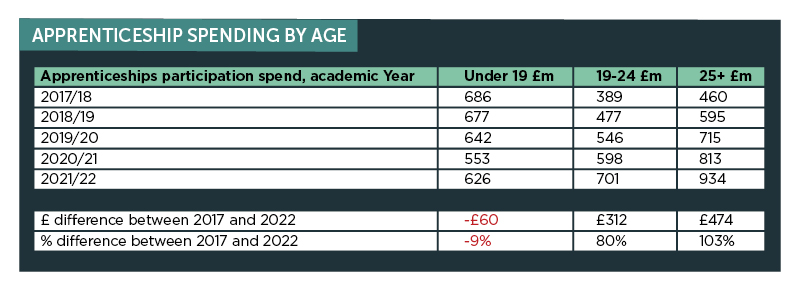Annual spending on level 2 apprenticeships has plummeted by more than £200 million since the launch of the levy – as money paid out for higher levels rockets, FE Week can reveal.
New figures obtained through a Freedom of Information request also show the only age group that has experienced a fall in apprenticeship spending over that period is 16 to 19-year-old school leavers.
Experts have put the trend down to the “clunky and arduous” apprenticeship system that small and medium-sized employers (SMEs), who have traditionally taken on a disproportionate number of lower level and young apprentices, struggle to navigate.
A Department for Education spokesperson said apprenticeships were “employer-led and businesses have flexibility to spend their levy funds to invest in the skill level they need”, adding that “these figures show they are doing that”.

Falling numbers of entry-level apprentices have been well reported since the launch of the apprenticeship levy in 2017, with latest official government data showing level 2 starts have dropped by two-fifths from 161,390 in 2017/18 to 91,520 in 2021/22.
But, because the government refuses to publish spending data for the levy, the sector is left to guess how much less funding this trend translates to.
FE Week can now reveal, for the first time, exactly how much funding has been spent on each level of apprenticeship in every year since the levy was introduced after obtaining the data under the FOI law.
It shows that level 2 apprenticeship participation spend dropped by a third, from £622 million in 2017/18 to £421 million in 2021/22.
All other levels experienced an increase in spending over the same period. Level 3 apprenticeship spending grew by more than quarter, before much bigger increases from level 4 onwards.
Spending on level 6 apprenticeships grew nine-fold, while level 7 apprenticeship spending was 20 times higher in 2021/22 than in 2017/18.
FE Week has also got hold of apprenticeship spending data by age for the first time. It shows that spending on apprenticeships for young people aged 16 to 19 fell by £60 million, or a tenth, from £686 million in 2017/18 to £626 million in 2021/22.
Meanwhile, spending on apprenticeships for 19 to 24-year-olds grew by £312 million, or four-fifths, from £389 million to £701 million, and spending on apprenticeships for those aged 25 and older went up by £474 million to £934 million in 2021/22, which is more than double the £460 million spent on this age group in 2017/18.

Since 2017, apprenticeships in England have been funded from a levy equivalent to 0.5 per cent of payroll imposed on large employers with annual wage bills above £3 million.
Levy payers can then use their levy pot to fund their apprenticeships. The levy was designed so that large employers would not spend all their contributions, with their unspent funding going towards paying for the rest of the system, such as apprenticeships for non-levy paying SMEs.
But SMEs have since complained that the system for signing up apprentices through the government’s digital apprenticeship service is too bureaucratic, time-consuming and complex, forcing many to turn their backs on apprenticeships.
Simon Ashworth, director of policy at the Association of Employment and Learning Providers, said: “Although the shift towards an employer and demand-led apprenticeship service has been a generally positive move, the system is still too clunky and arduous for SMEs. SMEs traditionally have taken on a disproportionate number of young people, particularly those at level 2.”
He added that the continuing lack of a level 2 business administration standard, which was a hugely popular apprenticeship under the old-style frameworks until it was switched off in 2020, has also impacted entry-level apprenticeship numbers.
Stephen Evans, chief executive at the Learning and Work Institute, calculated the real terms changes in spending for each level by adding inflation. This showed a £264 million, or two-fifths, drop in level 2 spending between 2017/18 and 2021/22.
He said the changes in spending were the “natural consequence of allowing free employer choice with few incentives to underpin investment in young people and apprenticeships at all levels”.
He added: “They reflect the historic pattern of employer investment in training, with graduates three times more likely to get training than non-graduates.
“The growth in higher apprenticeships is welcome, but this should not be at the expense of training at other levels and for young people. Learning at all levels boosts productivity and we need to tackle our historic shortfalls, or we will all be the poorer for it.”














Nothing to do with the Levy…get rid of all of the Level 2 Apprenticeship programmes and of course numbers will fall!!!
And guess what…bring back the much needed Business Administration Level 2 and numbers will grow again.
Come on…this isn’t nuclear scientist stuff is it? (An Apprenticeship Standard btw)
Totally agree with you Andrew Turner, we need to have the Business admin Level 2 back.
The apparently welcome increase in higher level apprenticeships is misleading. Larger firms that were already engaged in developing skills, such as the one I represent, were faced with a Levy that was in effect a tax, a punishment for not doing something that we have done very well for many years. We did what so many others have done, as far as possible, re-profile existing training activity to fit apprenticeship criteria, for funding purposes. These “new apprenticeships” are not new training, but their inclusion disguises the failure of Apprenticeship Levy in critical areas. This flawed strategy has added bureaucracy and cost, while adding no value.
Level 2 funding has dropped as there are less options at the level; popular starting place apprenticeships for school leavers have been withdrawn i.e. Business Admin 2 and Teaching Assistant 2. Bringing back these level 2 apprenticeships will offer more opportunities for the 16-18 year old learners, offering a stepping stone from school to employment.